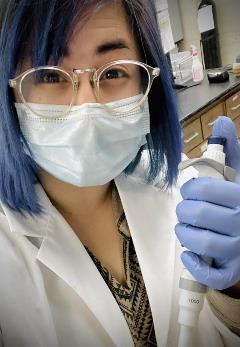June 14, 2021
 Grant: $1000 (Spring 2019)
Grant: $1000 (Spring 2019)
Education level at time of the grant: Graduate student
Project Description: While nanoparticles have huge potential as vehicles to improve the efficacy of drug delivery, one of the biggest challenges hindering their clinical success is surface fouling by serum proteins and premature clearance in the bloodstream circulation.
Using this Grant in Aid of Research award, I was able to develop and study PAIL-surface modified PLGA nanoparticles that not only resisted opsonization and extended circulation half-life inside a mouse, but also surprisingly hitchhiked red blood cells after intravenous administration to selectively accumulate in the lungs. Our findings suggest huge implications for the efficiency of delivering drugs to their designated targets in the body with our carrier design. By protecting drug integrity inside PLGA, a biocompatible FDA-approved polymer, and additionally capping the polymeric nanoparticle with PAIL, we can prevent the drug from being cleared immediately from the bloodstream and give it enough time to circulate and absorb into the target disease tissue, without inducing many side effects conventionally associated with administering the free drug.
With the assistance of the GIAR, we were able to complete transmission electron microscopy imaging to better understand the morphology and assembly of the PAIL surface coating. We also completed scanning electron microscopy in a time study to examine their binding to red blood cells in the mouse after injection. This work was published in the journal Science Advances in 2020.
How has the project influenced you as a scientist? I learned how to tell a compelling story to reviewers so scientists from different fields could understand the significance of my research and what I needed to complete the work. My GIAR award provided me a transformative opportunity, introducing me to new and diverse toolkits from physical chemistry, medicine, and bioengineering.
Where are you now? I followed my co-advisor, Dr. Eden Tanner, from Harvard to the University of Mississippi, where in the Tanner Lab I am continuing PhD research, investigating the physical chemistry driving the mechanism of interactions between PAIL-coated polymeric nanoparticles and red blood cells in whole blood to encourage selective cell hitchhiking and to drive targeted biodistribution for blood-based and cancer therapeutics.
Students may apply for Sigma Xi research grants by March 15 and October 1 annually at www.sigmaxi.org/giar.